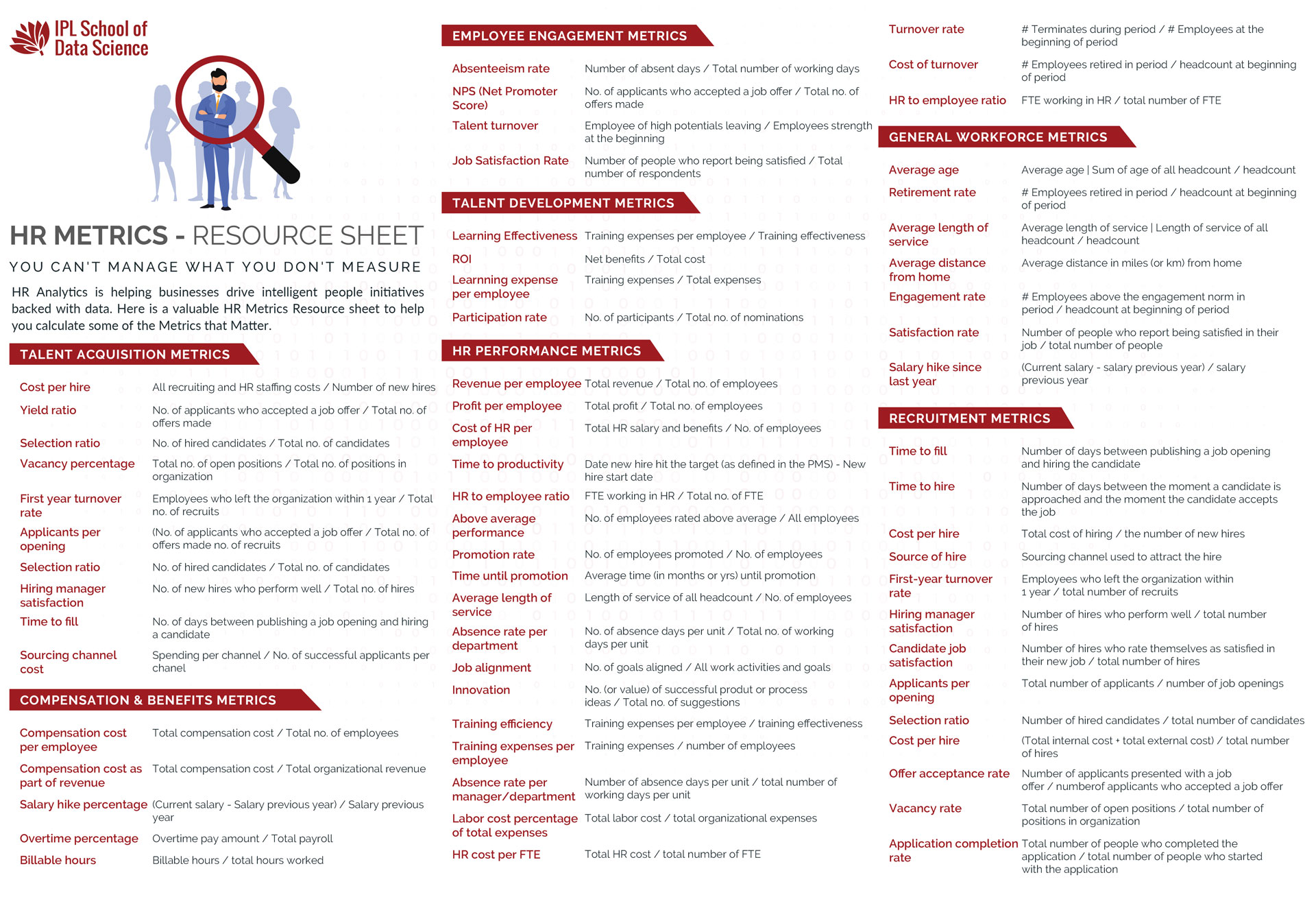Data Driven Human Resource Management

People form a key aspect of any organization. Organizations are nothing without the right people. Organizations that are able to attract people with the right skills and talent, nurture and grow them are most likely to have the competitive advantage needed to succeed now and in the future.
It is therefore important that organizations put in place the required systems and processes, to attract, recruit and retain the best talent.
While most of the human resources teams across the globe understand this need, yet too many HR teams spend the majority of their time on administrative tasks.
The advances in data, analytics, and artificial intelligence (AI), is changing this. Intelligent, data-driven HR is transforming many aspects of how HR teams serve the people in their organizations.
A lot of HR data analysis comes in the form of key performance indicators (KPIs) measuring factors like absenteeism or number of training hours per full time employee, sometimes because these metrics are easy to measure or because they are what other companies measure. These days there are far more unique and valuable metrics that can be measured, metrics that can deliver business critical insights and have a huge impact on an organization’s performance and results.
The role of the HR team is changing and, as our ability to gather and analyze ever-increasing amounts of data grows, so too do the opportunities for HR teams to add more value to the organization and help to achieve its strategic goals.
HR Metrics Resource Sheet
The rise of data-driven or intelligent HR:
As new quantifiable tools and analytics become available, HR is rapidly being disrupted by quantitative data on people. Companies now have access to information about their employees’ behavior and the business culture. One company, Sociometric Solutions, replaces work badges with meters that can capture a large range of data including who talks to whom at what times of the day, the pitch of voices, how people move and their work posture.
People analytics such as these allows HR to increase employee productivity, identify and develop the next generation of leaders (either within the company or with the new recruits) and track behavioral improvement.
What do we mean by data-driven HR?
Data-driven HR, or intelligent HR, is about using this data explosion in a smart way and extracting insights that not only improve the performance of people within the organization (including its HR team), but also contribute to the overall success of the organization.
HR teams can use data to make better HR decisions, better understand and evaluate the business impact of people, improve leadership’s decision making in people-related matters, make HR processes and operations more efficient and effective, and improve the overall well being and effectiveness of people, which all can have a significant impact on a company’s ability to achieve its strategic aims.
How can HR teams use data intelligently?
There are infinite ways in which businesses can make good use of data, but, in their most basic sense, they boil down to four main categories:
- Using data to make better decisions
- Using data to improve operations
- Using data to better understand your customers
- Monetize data
How data is already revolutionizing HR functions?
If we look at the core HR functions, there are very many real-world examples of how this idea of data-driven HR is already taking root.
- Data Driven Recruitment – Taking the guesswork out of recruitment
Recruitment is one area of HR that is particularly rich in data. HR teams which understand and work with big data are the ones which will recruit most successfully in the coming years and see the greatest ROI for their recruitment activities.
The key areas of recruitment that will benefit from data:
- Measuring, increasing and promoting your employer brand
- Identifying the most effective recruitment channels
- Identifying new recruitment channels
- Identifying and assessing the best people for your business
- Identifying candidates for top level positions
- Sourcing virtual workforce
- Identifying and promoting suitable candidates inside the company
Data Driven Employee Engagement:
With employees being frequently touted as the most valuable asset of a business, it makes sense that keeping those employees engaged, happy and committed to the company is a critical activity for any organization.
Areas of employee engagement that data can impact:
- Driving employee satisfaction (or how happy your people are) – Knowing what people are thinking and feeling
- Measuring and improving employee loyalty and retention
- Improving compensation and benefits with data
- Getting continuous feedback
- Measuring employee sentiment
- Measuring and improving employee retention
- Predicting employee churn
Data Driven Compensation and Benefits:
Though compensation and benefits is one of those less developed areas in terms of data and analytics, it is developing fast. More and more tools and services are coming onto the market to help companies take a more intelligent, data-driven approach to their compensation and benefits structures. Offering a fair compensation and benefits package remains an important part of successful employee engagement.
The ability to tailor your compensation and benefits packages to individuals, based on what the data tell you about different traits, will inspire greater long-term employee engagement.
Data Driven Learning and Development:
Learning and development (L&D), a core function of HR, is being transformed by big data technology. Even just a quick glimpse at the digital transformation happening right now in the world of education points to how data can facilitate learning at all levels, from schools and universities to corporate learning.
When learners work through the content in a digital course, they leave a digital trace of all their actions. This ability to track learners’ journeys gives training providers and L&D professionals the opportunity to understand a great deal about the learning experience. Indeed, most learning providers incorporate some sort of learning management system that tracks how learners progress and provides insights that can help both individual learners and the company-wide L&D programme.
The importance of learning analytics
Learning analytics should therefore underpin every aspect of employee learning, from developing better learning programmes, to delivering them in the most engaging way and tracking how employees interact with the programme. Data and analytics can also dramatically improve the measurement of L&D by showing how effective (or not) it is in practice.
Demonstrating value by linking training to performance
Data also allows HR teams to create clear, evidence-based links between training and performance, which is helpful for improving future L&D, establishing return on investment (ROI) and securing leadership buy-in for training programmes.






